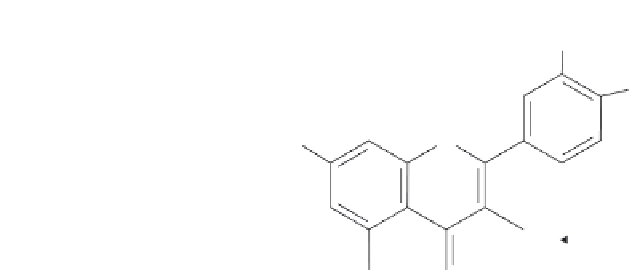Agriculture Reference
In-Depth Information
OH
3'
2'
OH
4'
B
1
8
1'
O
HO
5'
7
2
6'
A
C
6
3
OH
5
4
Sugar
OH
O
Fig. 12.1
Chemical structure of quercetin (a flavonol) to demonstrate the labeling of aromatic rings and num-
bering of the structure. The in vitro antioxidant properties of quercetin compounds are suggested depending on
three structural characteristics: 3
4
-dihydroxy phenyl groups of B ring; 2,3 double bond and 4-carboxy of C ring;
and 3-hydroxy substitution/glycosylation. Sugar substitution at C-3 position is common for naturally occurring
quercetins of fruits.
antioxidants with mechanisms involving both free radical scavenging and metal chelation.
They have ideal structural chemistry for free radical-scavenging activities, and have been
shown to be more effective antioxidants in vitro than vitamins E and C on a molar basis
(Rice-Evans et al., 1997).
In term of their role in fruits, flavonoids help to protect the fruit against damage by UV
light. The phenolic compounds also play an important role in fruit ripening by giving the
desired color and flavor to the fruit as in cherries, apples, plums, grapes, etc., and attracting
humans, animals, birds, and insects for seed dispersal. Besides, these polyphenolics serve
as parameters for judging the quality of the fruit and fruit products that include color, flavor,
texture, and shelf life. When fruit is unripe, the content and type of phenolic compounds
is different from the ripe fruit. For example, unripe fruits usually have high tannin content
that help to protect the fruit from environmental factors and to prevent from herbivores
animals. The phenolic compounds contributing to the flavor include tannins (hydrolysable
and condensed), which are associated with astringency in ciders, wine, and semidried banana
products. Citrus fruits such as grapefruits contain naringin as predominant bitter flavanones,
whereas, in oranges, naringin and neohesperidin are responsible for the bitterness (Rouseff
et al., 1987). Hence, the presence of the phenolic compounds is a major criterion for the
consumer selection of these fruits.
Recently, flavonoids have attracted a growing interest for their potential health benefits
in human health and nutrition, and the mitigation of numerous chronic diseases including
various types of cancers, cardiovascular diseases, and neurodegenerative disorders (Boyer
and Liu, 2004).
12.5 Biosynthesis of polyphenols
The major polyphenolics present in fruits belong to subgroups of phenolic acids (hydroxy-
benzoates and hydroxycinnamates) and flavonoids. Precursor of the majority of fruit phe-
nolic compounds is the aromatic amino acid,
L
-phenylalanine. The biosynthesis of pheny-
lalanine occurs through the shikimate or arogenate pathway (Fig. 12.2). The shikimate
pathway begins with the condensation of erythrose 4-phosphate (an intermediate of the
pentose phosphate pathway) and phosphoenolpyruvate (PEP, a glycolytic intermediate) to









Search WWH ::

Custom Search